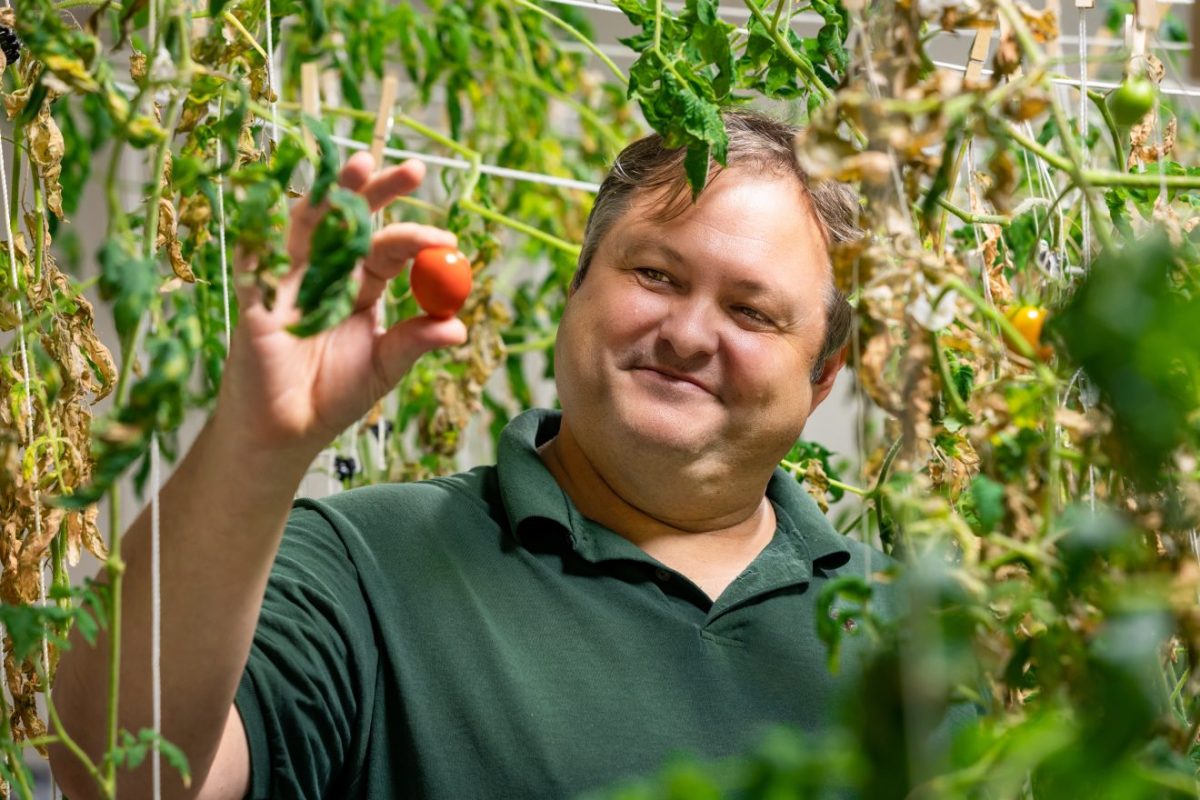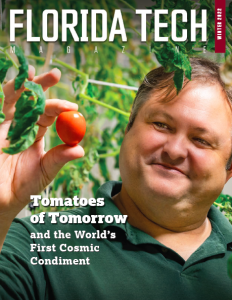Ketchup Out Of This World: Q&A with the Scientists Behind Heinz Tomato Ketchup ‘Marz Edition’
Dr. Andrew Palmer and his team successfully grew food-grade tomatoes in simulated Martian regolith.
In two rooms on the second floor of Florida Tech’s Center for Advanced Manufacturing and Innovative Design, amid a tangle of green plants and red fruit, a scientist and 15 of his students brought us a little closer to Mars.
Collaborating with global food business The Kraft Heinz Co., associate professor Andrew Palmer and his team succeeded in growing food-grade tomatoes in simulated Martian regolith—a dirt-like substance that is similar in composition to the actual surface material on Mars. With 450 plants and hundreds of tomatoes produced, this was a remarkable achievement in Martian farming on a scale rarely attempted.
The nearly two-year process resulted in an international sensation: Heinz Ketchup Marz Edition, the first ketchup made with tomatoes grown in Mars-like conditions. Though not available to the general public, the popular condiment represents the successful result of a process that reflected the true nature of scientific discovery: Some things worked; some didn’t, and plenty was learned.
What remained steadfast was the participants’ faith in a future that includes humans on Mars.
“I think it is inevitable that we will be colonizing other planets, especially Mars,” says Ruth Nichols, a sophomore and project participant majoring in astrobiology and applied mathematics. “The importance of this project is showing that the Martian regolith itself can be used for growing crops for human consumption.”
We talked to Palmer, undergraduates Nichols and Benjamin Sheely, an aerospace engineering–astronautics junior, and David Handy ’19, a second-year Ph.D. student in biological sciences, about this remarkable endeavor, what it means for our quest to colonize Mars and how it could end up making a big impact on Earth.
The interview has been condensed and edited for clarity.
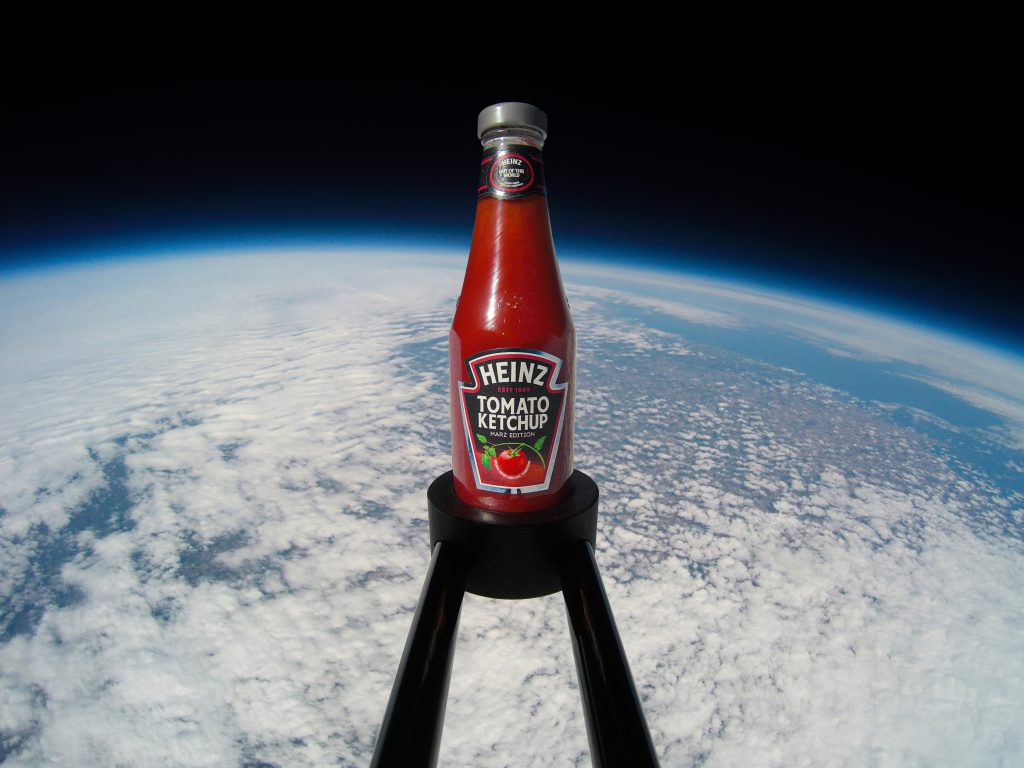
Q: You started with a pilot program of about 30 plants then scaled up to 450. That’s quite a leap. What did that teach you about this growing process?
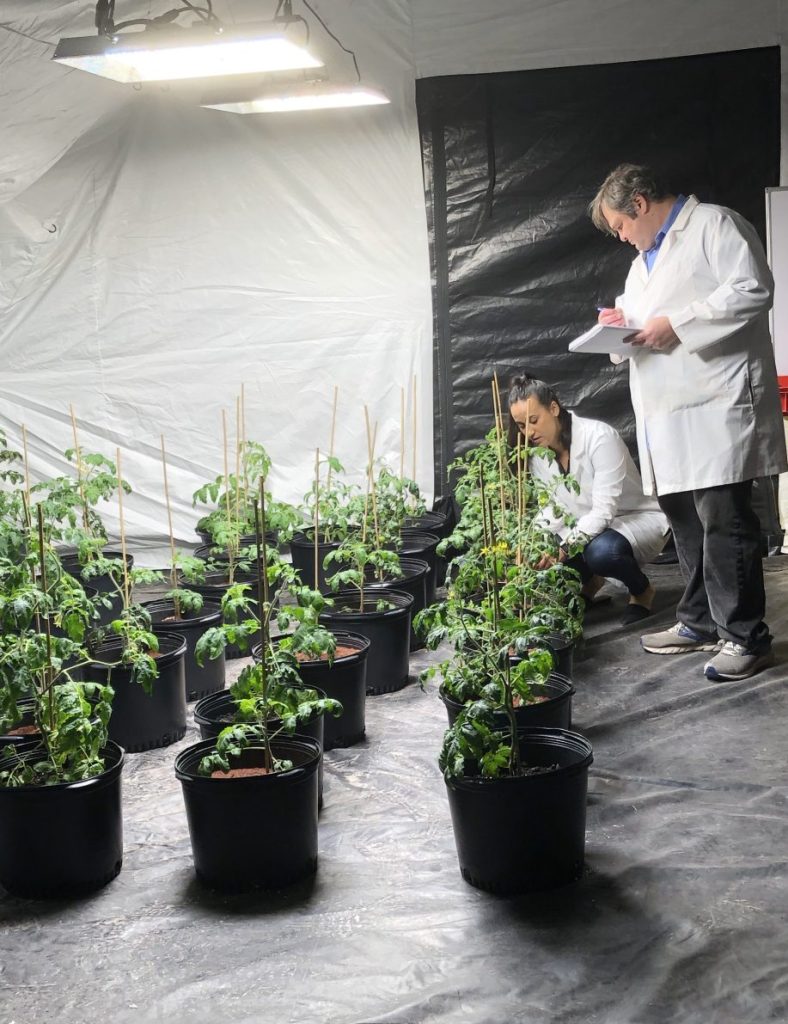
Andrew Palmer:
What we experienced is a really good example of how things don’t necessarily scale proportionally. What I mean by that is that we did this pilot study, and we did 30 plants, and we were convinced, ‘Okay, we know how to get the yield to work. We know how to optimize everything that we need to get the plants to grow.’ And then, we went from 30 plants to 450 plants, and it turned out that there were new problems.
So, we had to work on how to make sure that much larger group of plants got equal amounts of light. We had to make sure that temperature conditions and the entire room were the same as in the pilot study, which was harder in a bigger space. We had to keep airflow going so that plants were getting an equal amount of air. We had to figure out a watering schedule for all of these plants, handled by our students, because we wanted to optimize growth and couldn’t really set an automated watering system.
I think we also learned a lot about trying to grow in a monoculture approach, and we think that one of our take-home messages is, we don’t want to grow a room full of one thing. We want to diversify, and we think that’s going to give us a better nutrient profile in the regolith. The goal is to move to larger, trough-based systems, where the plants can intermingle, which allows them to complement each other. Also, when you have different plants, you reduce the spread of disease, and you have the potential to cultivate a better variety of microbial partners.
Benjamin Sheely:
To our group’s knowledge, this was the largest harvest attempt in Mars regolith ever conducted. Conducting experiments on a mass scale can provide a viewpoint perhaps missed with smaller sample sizes, regardless of the number of trials. Hopefully, our mass-scale experiment will add to the collective considerations for this research topic globally.
Q: The fact that Heinz made ketchup out of these tomatoes certainly captured the headlines, but what is the greater potential impact of this study?
Andrew Palmer:
I think there’s certainly intellectual value from learning from the challenges here. We’ve learned a lot about proper nutrient balance for growing plants like tomatoes. We’ve learned a lot about the actual amount of water that it’ll take to do a process like this with these conditions. We’ve learned a lot about how much artificial lighting we need to provide. We’ve learned about controlling day/night cycles. We’ve taken a lot of the stuff we already knew in traditional agriculture, started to apply it here and realized that a lot of it will hold up, with some tweaking.
I think a larger component of it, though, is inspirational. It’s about showing that this is hard work, but it’s work worth doing. This Martian agriculture is something we don’t have a high technological readiness level of, but we’re looking at, 20 years from now, trying to set up a Mars base; we’ve got the time to do it. I think we can’t thank Heinz enough for wanting to take the challenge, for trying to do this.
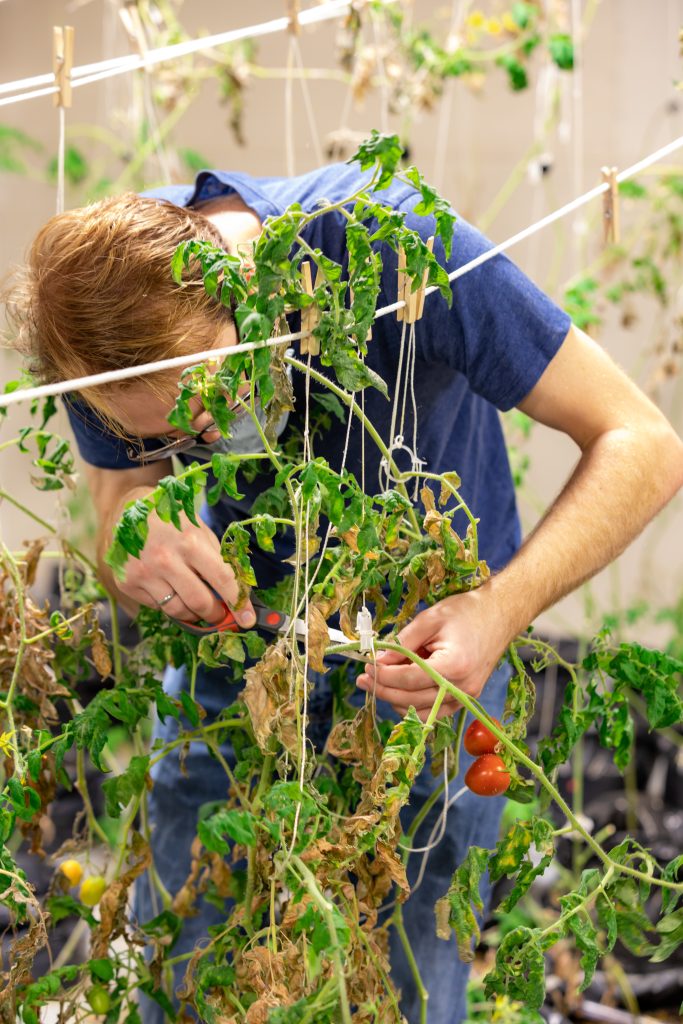
Ruth Nichols:
I think one of the most significant results of this project was proving that plants grown in Martian regolith simulant can be food-grade quality. Although we were sure the food would be fine for consumption, getting the confirmation is a big breakthrough.
Benjamin Sheely:
We can help narrow down corrective actions needed to optimize agriculture in nonfertile areas on Earth. Considering the moon or Mars, understanding the compositional boundaries of regoliths that Earth flora and bacteria can successfully thrive in now can allow for thorough analysis of sustaining life elsewhere through human agriculture with modifications.
David Handy:
My biggest takeaways were from the scale of it. As one of the people tending to the plants day to day, my experience really highlights the need for automation in things like irrigation systems. One of the things that the pilot study especially solidified is that we need to not only consider what crops, but what varietals of each crop, are used.
Q: After this experience, are you still confident that someday, humans will colonize Mars?
Andrew Palmer:
It’s a really good question. So, things didn’t work out here exactly as we planned, but until the very last couple of weeks, we had hundreds of tomatoes in this room. Then yes, something happened, and that was unexpected, and I think it points out, for one, how perilous agriculture is, no matter where it’s done. Disease or something goes wrong in the water supply or something happens, and farmers can lose a large portion of their crop. It’s not uncommon. The concern of that is certainly amplified when we think about Mars. We have to be able to grow food, and I think what we saw was that we successfully did that. We did produce hundreds of tomatoes that would be viable. Does it also tell me that the process is more difficult? Yes. It’s going to be even more challenging than I already thought, but that’s not a reason to think we can’t accomplish it. It just lays out a better sense of where we are.
Ruth Nichols:
I think it is inevitable that we will be colonizing other planets, especially Mars. One of the most crucial steps we must take for that to happen, though, is to make sure we have the food to sustain us there, and one of the best ways to go about making food on Mars is by utilizing the Martian regolith through in-situ resource utilization (ISRU). Carrying soil or equipment for growing crops in Earth-like conditions on Mars would take a lot of money and increase payloads. The importance of this project is showing that the Martian regolith itself can be used for growing crops for human consumption.
Benjamin Sheely:
Yes. The long-term benefits of this and future related work: Humans on Earth all have food. Humans not on Earth all have food.
David Handy:
I believe we definitely will one day, though how long it will take is going to depend on a lot of factors, especially politically when it comes to funding. I hope that this research can help us achieve self-sustainable colonies faster, where we plan to be growing food on these colonies from the start.
I think a larger component of it, though, is inspirational. It’s about showing that this is hard work, but it’s work worth doing.
Andrew Palmer, associate professor, Ocean Engineering and Marine Sciences
Q: Will growing things in regolith be the only approach to cultivating food on Mars?
Andrew Palmer:
I think, right now, we are exploring a variety of options. Growing in regolith is not going to be the only option for growing food on Mars and, in fact, it would be really foolish to put all of your eggs in one basket—or all of your seeds in one plot of soil. We see things like the film “The Martian,” and that’s influenced a lot of people’s opinions of what we could do on Mars. ‘I saw Matt Damon grow food on Mars!’ But let’s be clear: That is not a documentary.
We’ll have a mix of approaches. There’s going to be hydroponics and probably aeroponics, and then there’s going to be this regolith-based method. There’s going to be a mix of that with prepackaged foods that are going to come because there’s going to be things that it’s just going to be too costly to make on Mars right away. We’ll still have to rely on some things coming from Earth, but we’ll leverage the things that we know about hydroponics to grow certain types of food that we can grow better there than we can grow in our regolith. So, it’s going to be a blend.
Q: Does Heinz Tomato Ketchup Marz Edition taste like regular Heinz Tomato Ketchup?
Andrew Palmer:
You wouldn’t be able to taste the difference. The project’s aim was to see if Heinz and Florida Tech could grow tomatoes with all the correct properties, such as thickness, color and sweetness, to make the Heinz Tomato Ketchup traditionally grown in the fields. Mission accomplished!
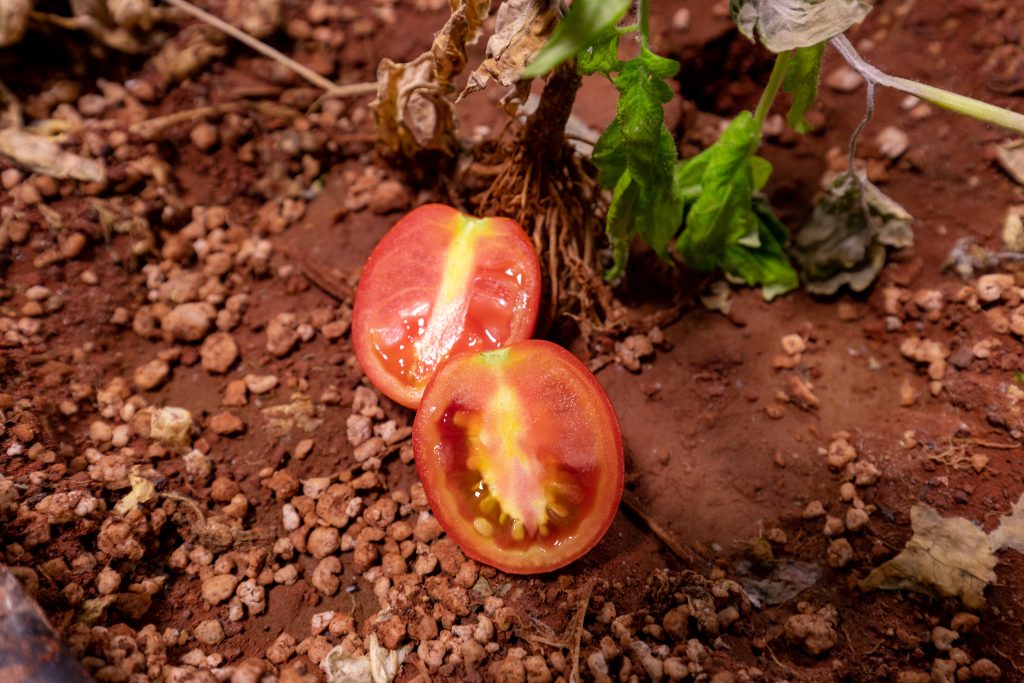
Beyond the tomatoes, what other Mars-related research projects are Andrew Palmer and his team involved in?
Martian Regolith
The team has been doing research into different Martian soil simulants. Understanding that, as on Earth, soil is different chemically and mineralogically from one place to the next on Mars, they are working to catalog how Earth-derived regolith simulants mimic what is found on the red planet in an effort to create a standardized procedure for investigating these different substrates.
Palmer says: “We can actually go through and investigate and interrogate which one of those is going to be better for growing plants, which could help us when we decide to land, someday, on Mars and set up a colony. We could say, ‘Well, it’ll be a lot easier to grow plants if you land at this site than if you land at this site.’”
Improving Plant Growth
When plants grow in Earth’s soil, they are surrounded by bacterial and fungal “assistants.” These things help take nutrients that may be hard for plants to absorb, such as phosphorus and nitrogen, and make them more usable for the plants. So, the team is now working on growing different bacteria and different fungi and growing them with plants to see if they can improve growth. What Palmer and his team are developing could eventually be added to Martian regolith to help plants grow.
Palmer says: “So, we’re leveraging the microbial world now, and instead of creating this super sterile environment, we’re trying to create a bacteria-rich environment, but with the bacteria we want, which will help the plants grow better.”
This piece was featured in the winter 2022 edition of Florida Tech Magazine.

